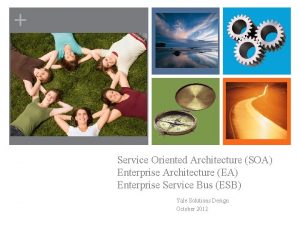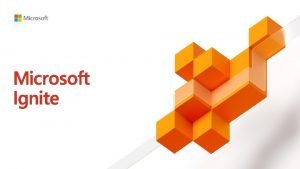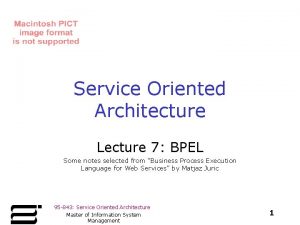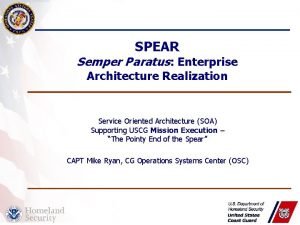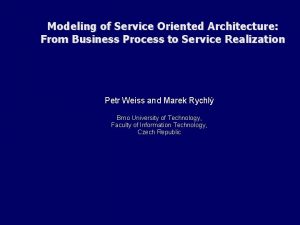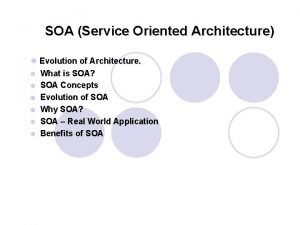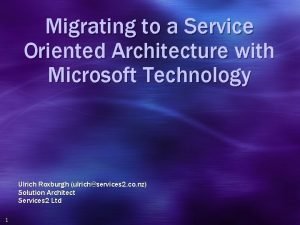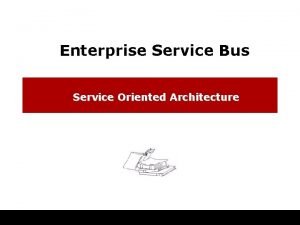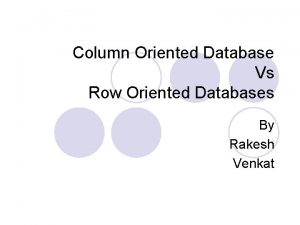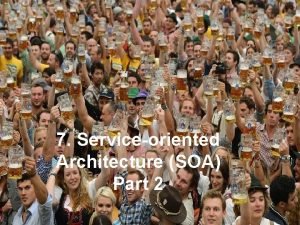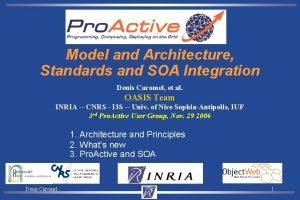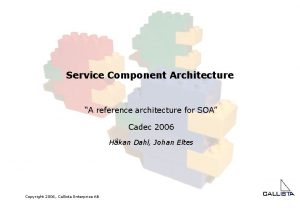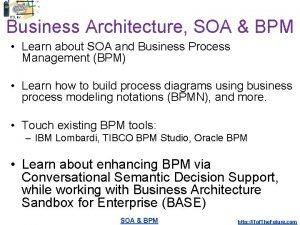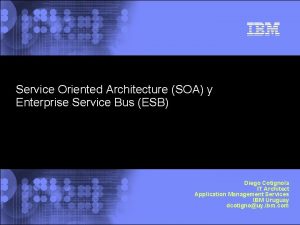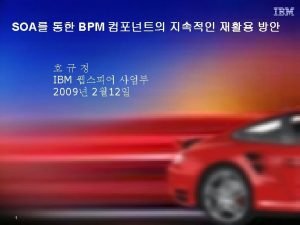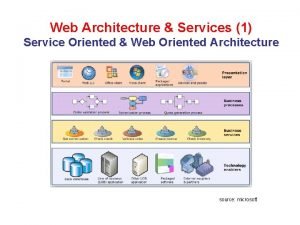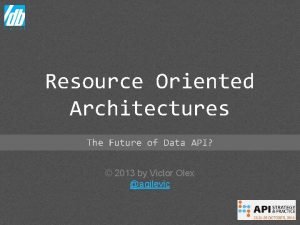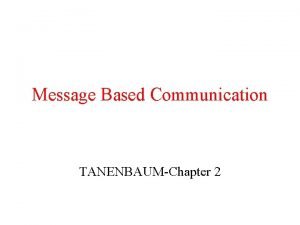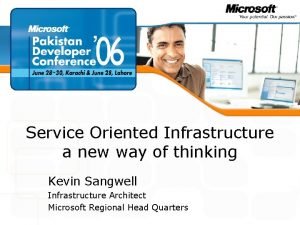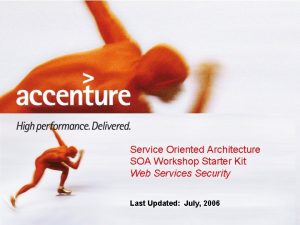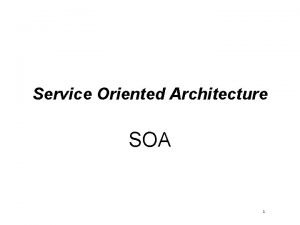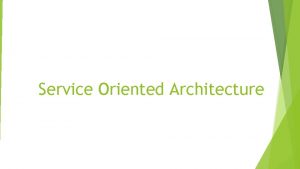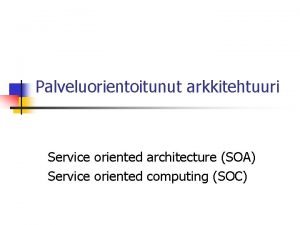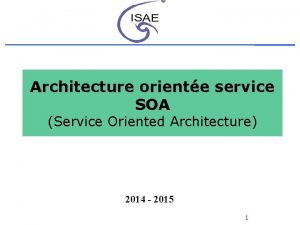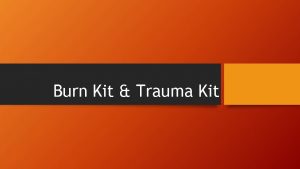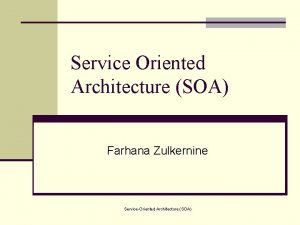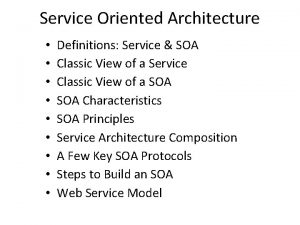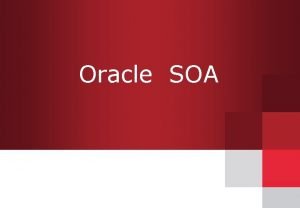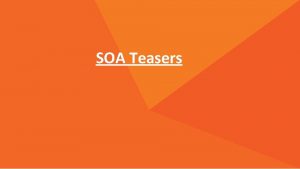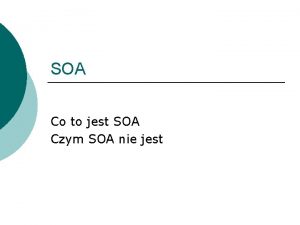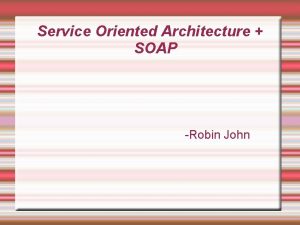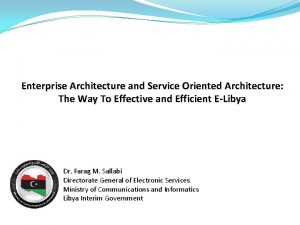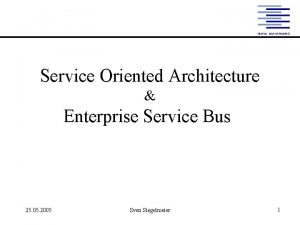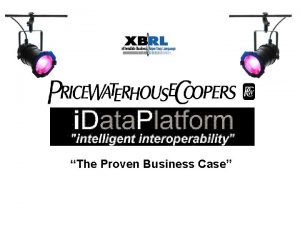Service Oriented Architecture SOA Workshop Starter Kit Enterprise

























- Slides: 25

Service Oriented Architecture SOA Workshop Starter Kit Enterprise Service Bus (ESB) POV Last Updated: July, 2006

SOA Workshop Starter Kit – ESB POV SOA Workshop Starter Kit Sponsor: David L. Nichols Last Updated: July, 2006 Version: 2. 0 Intent of Section: This document provides an overview of the Enterprise Service Bus concepts, architecture and use cases Intended Audience: For internal and external use (Unless otherwise documented) Master Document: Enterprise Service Bus POV Hot Topic v 1. ppt July, 2005 https: //kx. accenture. com/_layouts/kx/dispcontribution form. aspx? listitemid=67650&listid=Contributions To Find Additional SOA content: https: //technology. accenture. com/SOA Copyright © 2006 Accenture All Rights Reserved. SOA Workshop – V 2. 0 2

Contents • ESB Introduction • ESB Architecture • ESB Use Cases & Example Copyright © 2006 Accenture All Rights Reserved. SOA Workshop – V 2. 0 3

What is an ESB? Common agreed elements of ESB definition: • Provides an integration infrastructure consistent with SOA principles: • • • use of implementation-independent interfaces, communication protocols that stress location transparency and interoperability, service definitions that are relatively coarse-grained and encapsulate reusable function Can be implemented as a distributed, heterogeneous infrastructure • Provides the means to manage the service infrastructure and to operate in today’s distributed, heterogeneous environment Fundamental ESB Characteristics: • XML, Messaging, Transformation, Intelligent Routing services • Connectivity (Web Services, J 2 EE Connector Arch. , JMS, COM etc. ) • Support for highly distributed deployments, SOA • Copyright © 2006 Accenture All Rights Reserved. SOA Workshop – V 2. 0 4

What is an ESB? “An Enterprise Service Bus (ESB) is a new architecture that exploits Web services, messaging middleware, intelligent routing, and transformation. ESBs act as a lightweight, ubiquitous integration backbone through which software services and application components flow. *” “The Enterprise Service Bus is a uniform service integration architecture of infrastructure services that provides consistent support to business services across a defined ecosystem. The ESB is implemented as a service oriented architecture using Web Service interfaces. ” CBDI * © Source: Roy Schulte, Gartner, Inc. Copyright © 2006 Accenture All Rights Reserved. . SOA Workshop – V 2. 0 5

Our View of ESBs • • • ESBs have emerged as a new type of middleware (and product category), implementing features found in earlier middleware, but with emphasis on Web Services support (XML, SOAP, WSDL) and SOA relevant characteristics ESBs are an architectural approach. They are an architectural pattern for SOA implementation and a BUS for lightweight Integration. It supports intelligently directed communication and mediated relationships among loosely coupled and decoupled business components They are an integration backbone and Web-services-capable infrastructure Can be highly distributed, and implemented in a very heterogeneous environment An Utility Layer (or Execution Framework Layer) can provide additional capabilities and services to the ESB like security, process orchestration, transaction and services management, directory, BAM, etc. - that enable an enterprise class solution ESB tools can jumpstart the building and deployment of an SOA Copyright © 2006 Accenture All Rights Reserved. SOA Workshop – V 2. 0 6

The ESB: The Universal Integration Middleware Application Layer ERP HR Custom Applications • • Proprietary interfaces Applications changes are less often Copyright © 2006 Accenture All Rights Reserved. Solutions Enterprise Service Bus (XML Web Services) CRM Presentation Layer Business Process Orchestration Directory Utility Framework Services . NET Technical Service Bus (Messaging, JMS, CORBA, “Web Services”, etc. ) Legacy Applications Utility Layer Services Management Data Management Web Services Publish / Subscribe Transformation Adapters Connectivity • • Transformation Services Composition Integration Guaranteed Delivery • • Composite Service Web Tier` Composite Service Desktop Platform Composite Service IVR Platform Composite Service Directory Services Management Business Services Infrastructure Services SOA Workshop – V 2. 0 B 2 B Gateway • • Multi-channel (devices) Changes often 7

ESBs: translating into a Services Model Composite Business Services Presentation Layer (Solutions) Portal 1 Portal 2 … … Portal p Dedicated Business Service 1 Service 2 Service 3 … Service n Shared, Enterprise Business Services Utility Layer Get_Customer _Contact Get_Order_ Status Get_Service_ History … Service m Shared, Enterprise Infrastructure Services Semantic Integration – Data Services Security and Entitlement Services Other Services: Messaging, Connectivity, Qo. S, Brokering, etc. Application Layer Copyright © 2006 Accenture All Rights Reserved. App 2 … SOA Workshop – V 2. 0 … App P 8

What vendors say about ESB? All Vendors are flexible in defining ESB. Their definition always manages to show that their current solutions are using it • • Some stress the role of the ESB in e. Business, its inter-organizational. Rather than intra-organizational role Almost all believe, that the ESB is more than the bus it runs on. Essentially, they are describing a service-oriented architecture from another viewpoint Some see orchestration as part of the ESB architecture, others do not Some package MOM and EAI in their ESB products Some identify event monitoring as the major differentiator from MOM Some consider services management as part of the ESB solution Some see an ESB as strictly related to Web services and describe it as a Web Services Network. Vendors Defined Gartner defined ESB to describe a group of lightweight Middleware Integration applications Copyright © 2006 Accenture All Rights Reserved. their pre-existing Applications as ESB tools Small Vendors Create pure-play ESB tools SOA Workshop – V 2. 0 9

Vendors that started with a SOAP/http emphasis are converging into multi-protocol ESBs Multiprotocol ESBs SOAP/http ESBs • • Cape Clear Systinet Sonic Software Blue Titan Web. Methods Fabric • • • IBM’s WBI See. Beyond Tibco Web. Methods SAP Net. Weaver XI Oracle IONA Technologies' Artix Microsoft's Indigo (future product) Vitria Polar. Lake's JIntegrator Fiorano Software's ESB Software AG “More than half of all large enterprises will have an ESB running by year-end 2006 (0. 7 probability). ” © Copyright Gartner, Inc. [Source: Predicts 2005: Application Integration, ESBs and B 2 B Evolve - 1 November 2004] Copyright © 2006 Accenture All Rights Reserved. SOA Workshop – V 2. 0 10

What is an ESB? – General Vendor Consensus • • • ESBs (as products) are a set technologies developed to support program-to -program communication/integration (such as Web services, Object request brokers, Remote procedure calls, MOM, etc. ) and SOA ESB is a product category in the integration market ESBs are seen as a potential evolution of middleware technologies • All in one package (Administration and Management services, Service Definition tools and Repository services) Combine features from previous integration technologies • Provide value added services: • • Intelligent Routing Message validation Transformation Security Load balancing, etc. Support highly distributed architectures Copyright © 2006 Accenture All Rights Reserved. SOA Workshop – V 2. 0 11

ESB Benefits – What’s new An ESB provides the same basic functionality as an EAI broker - connectivity, application adapters, routing of messages based on rules, and data transformation engine - yet, in a true ESB, these capabilities are themselves SOA based in that they are spread out across the bus in a highly distributed fashion and hosted in separately deployable service containers* • • ESB addresses the challenge in assembling, deploying, managing distributed SOAs Traditional Systems rely on a tight semantic coupling between apps, if one goes down everything follows. ESB does not ESB provides distributed processing, standards based integration, enterprise class backbone Physical connections are abstracted (ease of redeployment) Destination Independence May include Business logic and workflow May include content-based routing and filtering (*) Dave Chappel: ESB Myth Busters: 10 Enterprise Service Bus Myths Debunked Copyright © 2006 Accenture All Rights Reserved. SOA Workshop – V 2. 0 12

Traditional EAI vs ESB A number of ESBs are part of an EAI solution. Others however, are there to replace it. The key differences are similar to the ones between conventional EAI and SOA Reliance on a hub-and-spoke architecture Service Oriented Architectures Functionality Oriented Process Oriented Designed to last Designed to change ( Standardized architecture) Long development cycle Iterative development and deployment Cost centered Business centered Application Block Services Orchestration Tightly Coupled with use of proprietary adapters Loosely Coupled with brokerless, Coarse-grained Business Services Object and Message Oriented Known Implementation Abstraction Complex, proprietary, centralized, and costly integration Copyright © 2006 Accenture All Rights Reserved. Flexible and adaptive business logic - Lack of support for new business logic Interoperability ESB + Traditional EAI Lightweight, distributed, standards-based and inexpensive SOA Workshop – V 2. 0 13

ESB, When to Consider • When deploying SOA across the enterprise • When establishing business processes (BPM) and orchestration infrastructure that will leverage a business services layer • When moving from a complex point-to-point or ‘spaghetti’ architecture to a more manageable and flexible IT infrastructure • When integrating to multiple and heterogeneous data sources and applications • When there is heavy business logic and security through the service bus to multiple end points • When further separation from composite applications is required (away from underlying implementations) • When flexible coupling is required Copyright © 2006 Accenture All Rights Reserved. SOA Workshop – V 2. 0 14

Contents • ESB Introduction • ESB Architecture • ESB Use Cases & Example Copyright © 2006 Accenture All Rights Reserved. SOA Workshop – V 2. 0 15

ESB Architecture Web Services An ESB offers a backbone that can extend MOM through the entire business, connecting components across different business sectors. It has its own communication capabilities JCA Management Framework Service Provider Service Consumer Messaging Framework Workflow Engine Service call Business Service Bus ESB Repository Process Orchestration Enterprise Service Bus Communication Layer Middleware Repository Middleware and Platform resources Service Providing Application – Existing Application Resources Service Consuming Application Communication Points Business Component Process Dynamic Trace/Log Application Repository Dynamic Routing Transport Transformation (XML Schema) Participation Mgt Service Mgt Policy/Security a) New Application requests information through SOAP/HTTP, JMS etc b) Content based routing to the Service Providing Application after authentication and application of orchestration rules c) Service provider receives request and responds through JCA, SOAP/HTTP etc. Copyright © 2006 Accenture All Rights Reserved. SOA Workshop – V 2. 0 Directory Persistence 16

ESB Architecture • Underlying an ESB architecture is an enterprise class, standards-based messaging backbone. This provides communications between any number of applications across the enterprise Business Service Bus Process Orchestration Enterprise Service Bus Communication Layer • ESB peers at the end-points of the network allow the components of a distributed application to exchange data concurrently • ESB Peers provide support to monitor locally running services • A Service connected to an ESB peer typically logs data, especially in the case of error conditions • ESB Peers implement the necessary support to allow/deny access to Services and Applications based on the security policies. Distributed Security Model. Copyright © 2006 Accenture All Rights Reserved. ESB Peers SOA Workshop – V 2. 0 17

ESB Architecture Administration & Management services (Single point of Control, Dynamic Change, Deployment Support) • • • The Service Bus • Communications: Asynchronous, message based, Store & FWD, JMS based • XML Support • Transformation Services • Intelligent Routing Definition tools Repository services MOM Facilities • Publish/Subscribe Support for Highly Distributed implementations • Service based approach • Location/Technology Transparency Connectivity Services (WS, JMS, JCA, etc) Copyright © 2006 Accenture All Rights Reserved. SOA Workshop – V 2. 0 18

ESB Implementation Guidelines The ESB should • Follow all SOA guidelines • Be the basis of an extensible framework into which other ISB can be connected • Provide capabilities to enable the business service bus (E. g. Aggregation, Service Composition) • Not be based on a single transport – but instead must support multiple transports • Support a variety of security and transactional models between service consumers and service providers • Not introduce product dependencies on any Service Endpoints • Be Service-Based to enable loose coupling of infrastructure resources • Support industry technologies (SOAP, WSDL, COM, CICS, . NET, JMS, JCA, JDBC, Web services etc), but also provide support for the full range of emerging Web Service Protocols • Be Policy and Metadata driven. To enable easy configuration without programming • Be secure, manageable and reliable SOA Workshop – V 2. 0 Copyright © 2006 Accenture All Rights Reserved. 19

Contents • ESB Introduction • ESB Architecture • ESB Use Cases & Example Copyright © 2006 Accenture All Rights Reserved. SOA Workshop – V 2. 0 20

ESB Use Cases • Enterprise Wide SOA • • • Many-Many Enterprise level integration Multiple applications to multiple services Alternating Service Consumers and Service Providers Legacy integration and all platform support Application Wrapping Copyright © 2006 Accenture All Rights Reserved. SOA Workshop – V 2. 0 21

ESB Use Cases Application Integration • • Many-Many Application Integration Data Transformation Routing Data Synchronization Composite Applications • Copyright © 2006 Accenture All Rights Reserved. SOA Workshop – V 2. 0 BPM, heavy orchestration 22

ESB Example: Telematics Application Platform Overview : A service aggregator platform. It forms the server gateway between richer -client, over-the-air programmable, in-vehicle telematics devices, wireless networks and net-centric applications, services and content, and enterprise information systems (EIS). Functionality: e. Commerce infrastructure with event-based billing, subscriptions, account management and prepay facilities. Architectural Requirements: ESB backbone, Service Aggregation and Delivery Platform, Highly scalable Multi-channel delivery of content and services, Device / Service Abstraction Copyright © 2006 Accenture All Rights Reserved. SOA Workshop – V 2. 0 23

ESB Example: Integration Infrastructure Overview : Use of an Enterprise Service Bus to integrate to pre-existing application. Service and Process Orchestration is located over the Business Service Bus Functionality: e. Commerce infrastructure with CRM and ERP pre-existing systems Architectural Requirements: J 2 EE Architecture, Orchestration Server, Security Server, Management, ESB. Copyright © 2006 Accenture All Rights Reserved. SOA Workshop – V 2. 0 24

ESB Example: Integration Infrastructure Overview : Use of an Enterprise service Bus to co-exist with existing middleware in order to improve availability of messaging. Upgrade from point-point integration. Functionality: Ecommerce infrastructure with multiple Integration infrastructures Architectural Requirements: ESB, multiple EAIs, multiple middleware, standardization, cover current architectures and launch them as Web-Services. Copyright © 2006 Accenture All Rights Reserved. SOA Workshop – V 2. 0 25
 Soa enterprise architecture
Soa enterprise architecture Define citizen developer
Define citizen developer Service oriented architecture notes
Service oriented architecture notes Characteristics of service oriented architecture
Characteristics of service oriented architecture Fiorano esb
Fiorano esb Service oriented architecture diagram
Service oriented architecture diagram Disadvantages of service oriented architecture
Disadvantages of service oriented architecture Service oriented architecture soap
Service oriented architecture soap Soa
Soa Enterprise service bus architecture
Enterprise service bus architecture Consumer oriented vs trade-oriented sales promotion
Consumer oriented vs trade-oriented sales promotion What is a column row db
What is a column row db Soa architecture
Soa architecture Soa reference architecture
Soa reference architecture Soa reference architecture
Soa reference architecture Soa reference architecture
Soa reference architecture Soa 2002
Soa 2002 Ibm bpm architecture diagram
Ibm bpm architecture diagram Service bus soa
Service bus soa Soa service lifecycle
Soa service lifecycle Putting the enterprise into the enterprise system
Putting the enterprise into the enterprise system Putting the enterprise into the enterprise system
Putting the enterprise into the enterprise system Service oriented web application
Service oriented web application Resource oriented architecture
Resource oriented architecture Message oriented architecture
Message oriented architecture Service oriented infrastructure
Service oriented infrastructure
